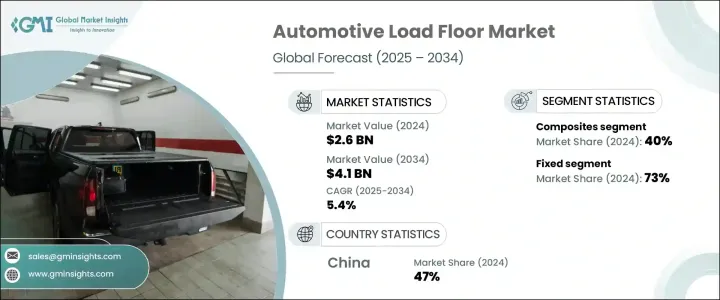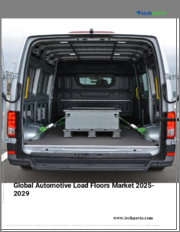
|
시장보고서
상품코드
1708147
세계의 자동차 로드 플로어 시장 기회, 성장 촉진요인, 산업 동향 분석 및 예측(2025-2034년)Automotive Load Floor Market Opportunity, Growth Drivers, Industry Trend Analysis, and Forecast 2025 - 2034 |
||||||
세계 자동차 로드 플로어 시장은 2024년 26억 달러에 달했고, 2025-2034년 연평균 5.4%의 성장률을 보일 것으로 예측됩니다.
이러한 확대는 고급 디자인과 향상된 기능을 필요로 하는 전기차 및 자율주행차(EV 및 AV)에 대한 수요 증가로 인해 더욱 가속화되고 있습니다. 전기자동차의 배터리 팩은 일반적으로 바닥 아래에 배치되기 때문에 자동차 제조업체들은 초경량이지만 내구성이 뛰어난 트렁크 플로어에 점점 더 많은 관심을 기울이고 있습니다. 그 결과, 복합재료와 열가소성 플라스틱과 같은 첨단 소재가 공간 효율성 향상, 적재 공간 용량 최적화, 구조적 무결성 유지를 위해 채택되고 있습니다.

연비와 지속가능성에 대한 관심이 높아짐에 따라 제조업체들은 탄소 발자국을 줄이기 위해 경량 소재를 우선시하고 있습니다. 비강화 폴리머 복합재, 열가소성 플라스틱, 벌집 구조를 적재공간에 적용하는 것은 내구성을 희생하지 않고 전체 차량 무게를 줄이는 데 중요한 역할을 합니다. 이러한 추세는 자동차 제조업체들이 엄격한 배기가스 규제와 연비 개선에 힘쓰고 있는 가운데 더욱 가속화되고 있습니다. 지속 가능한 솔루션으로의 전환은 소비자의 인식이 높아지고 친환경 자동차 부품에 초점을 맞춘 규제 의무화로 인해 더욱 가속화되고 있습니다. 고성능 소재에 대한 수요는 기능성과 편안함을 향상시키기 위해 가볍고 견고한 카고 플로어 솔루션이 필수적인 프리미엄 및 고급 차량의 생산량 증가로 인해 더욱 증가하고 있습니다.
| 시장 범위 | |
|---|---|
| 시작 연도 | 2024년 |
| 예측 연도 | 2025-2034년 |
| 시작 금액 | 26억 달러 |
| 예상 금액 | 41억 달러 |
| CAGR | 5.4% |
시장은 하드보드, 허니컴 폴리프로필렌, 플루티드 폴리프로필렌, 복합재 등 소재 유형별로 구분됩니다. 복합재료는 경량, 고강도, 내습성이 우수하여 2024년 40%의 점유율로 시장을 독점하고 있습니다. 탄소섬유강화플라스틱(CFRP)과 유리섬유 복합재료는 차량 중량을 효과적으로 줄이면서 우수한 구조적 지지력을 제공하기 때문에 인기를 끌고 있습니다. 이 소재들은 연비 효율과 탄소 배출량 감소에 크게 기여하기 때문에 지속가능성 목표를 달성하고자 하는 자동차 제조업체들이 선호하는 소재입니다.
화물칸 바닥은 작동 특성에 따라 고정형과 슬라이딩형으로 구분되며, 2024년에는 고정형 화물칸 바닥이 시장 점유율의 73%를 차지했으며, 향후에도 높은 성장세를 보일 것으로 전망됩니다. 고정식 화물칸 바닥은 뛰어난 구조적 안정성, 내구성 및 비용 효율성을 제공하여 승용차 및 상용차의 표준 선택이 되었습니다. 이러한 플로어는 최적의 하중 분산과 향상된 안전성을 보장하기 때문에 슬라이딩 방식에 비해 유리합니다.
중국의 자동차 로드 플로어 시장은 2024년 5억 2,000만 달러 규모에 달했으며, 중국 전기차 부문의 급격한 성장으로 인해 세계 시장을 선도하고 있습니다. 경량화 및 고성능 카고 플로어 솔루션에 대한 수요 증가는 복합소재 및 친환경 소재의 사용을 장려하는 정부의 장려책에 의해 더욱 강화되고 있습니다. 지원 정책, 기술 발전, 국내 자동차 제조업체의 확장과 함께 중국은 자동차 트렁크 플로어 산업의 주요 기업로서의 입지를 강화하고 있습니다. 세계 시장이 더 큰 지속가능성과 혁신을 향해 나아가는 가운데 중국의 역할은 자동차 트렁크 바닥 솔루션의 미래 전망을 형성하는 데 있어 매우 중요한 역할을 할 것으로 예측됩니다.
목차
제1장 조사 방법과 조사 범위
제2장 주요 요약
제3장 업계 인사이트
- 생태계 분석
- 공급업체 상황
- 원재료 공급업체
- 부품 제조업체
- Tier 1 공급업체
- OEM
- 애프터마켓 및 공급업체
- 이익률 분석
- 가격 동향
- 기술 및 혁신 전망
- 특허 분석
- 주요 뉴스
- 규제 상황
- 영향요인
- 성장 촉진요인
- 업계의 잠재적 리스크&과제
- 성장 가능성 분석
- Porter's Five Forces 분석
- PESTEL 분석
제4장 경쟁 구도
- 서론
- 기업 점유율 분석
- 경쟁 포지셔닝 매트릭스
- 전략 전망 매트릭스
제5장 시장 추산 및 예측 : 재료별, 2021년-2034년
- 주요 동향
- 하드보드
- 플룻 폴리프로필렌
- 허니콤 폴리프로필렌
- 복합재료
제6장 시장 추산 및 예측 : 조작별, 2021년-2034년
- 주요 동향
- 고정식
- 슬라이드식
제7장 시장 추산 및 예측 : 차량별, 2021년-2034년
- 주요 동향
- 승용차
- 해치백
- 세단
- SUV 차량
- 상용차
- 소형 상용차(LCV)
- 중형 상용차(MCV)
- 대형 상용차(HCV)
제8장 시장 추산 및 예측 : 판매채널별, 2021년-2034년
- 주요 동향
- OEM
- 애프터마켓
제9장 시장 추산 및 예측 : 지역별, 2021년-2034년
- 주요 동향
- 북미
- 미국
- 캐나다
- 유럽
- 영국
- 독일
- 프랑스
- 이탈리아
- 스페인
- 러시아
- 북유럽
- 아시아태평양
- 중국
- 인도
- 일본
- 한국
- 뉴질랜드
- 동남아시아
- 라틴아메리카
- 브라질
- 멕시코
- 아르헨티나
- 중동 및 아프리카
- 아랍에미리트(UAE)
- 사우디아라비아
- 남아프리카공화국
제10장 기업 개요
- ABC Technologies
- Applied Component Technology
- Arlington Industries
- ASG Group
- Autoneum
- CIE Automotive
- Covestro
- DS Smith
- Gemini Group
- Grudem
- Huntsman
- IDEAL Automotive
- KRAIBURG TPE
- Nagase America
- Recticel
- SA Automotive
- Sonoco Products
- Tricel Honeycomb
- UFP Technologies
- Woodbridge
The Global Automotive Load Floor Market reached USD 2.6 billion in 2024 and is projected to grow at a CAGR of 5.4% during 2025-2034. This expansion is fueled by the rising demand for electric and autonomous vehicles (EVs and AVs), which require advanced designs and enhanced functionality. Automakers are increasingly focusing on ultra-lightweight yet durable load floors, as battery packs in electric vehicles are typically positioned beneath the floor. As a result, advanced materials like composites and thermoplastics are being adopted to improve space efficiency, optimize cargo capacity, and maintain structural integrity.

With a growing emphasis on fuel economy and sustainability, manufacturers are prioritizing lightweight materials to reduce carbon footprints. The integration of non-reinforced polymer composites, thermoplastics, and honeycomb structures into load floors plays a crucial role in lowering overall vehicle weight without sacrificing durability. This trend is gaining momentum as automakers work toward stringent emissions regulations and improved fuel efficiency. The shift toward sustainable solutions is further accelerated by increasing consumer awareness and regulatory mandates focusing on eco-friendly automotive components. The demand for high-performance materials is also driven by the rising production of premium and luxury vehicles, where lightweight yet robust load floor solutions are essential for enhanced functionality and comfort.
| Market Scope | |
|---|---|
| Start Year | 2024 |
| Forecast Year | 2025-2034 |
| Start Value | $2.6 billion |
| Forecast Value | $4.1 billion |
| CAGR | 5.4% |
The market is segmented by material type, including hardboard, honeycomb polypropylene, fluted polypropylene, and composites. Composites dominated the market in 2024 with a 40% share, driven by their lightweight, high-strength, and moisture-resistant properties. Carbon fiber reinforced plastic (CFRP) and glass fiber composite materials are gaining traction as they offer superior structural support while effectively reducing vehicle weight. These materials contribute significantly to fuel efficiency and lower carbon emissions, making them a preferred choice among automakers striving to meet sustainability goals.
Load floors are classified into fixed and sliding systems based on their operational characteristics. In 2024, fixed load floors accounted for 73% of the market share and are expected to continue experiencing robust growth. Fixed-load floors provide exceptional structural stability, durability, and cost-efficiency, making them the standard choice for passenger and commercial vehicles. These floors ensure optimal load distribution and enhanced security, making them more favorable than sliding alternatives.
China Automotive Load Floor Market generated USD 520 million in 2024, leading the global market due to the country's rapidly growing electric vehicle sector. Increasing demand for lightweight, high-performance load floor solutions is further reinforced by government incentives promoting the use of composites and environmentally friendly materials. The combination of supportive policies, technological advancements, and the expansion of domestic automakers strengthens China's position as a key player in the automotive load floor industry. As the global market moves toward greater sustainability and innovation, China's role is expected to remain pivotal in shaping the future landscape of automotive load floor solutions.
Table of Contents
Chapter 1 Methodology & Scope
- 1.1 Research design
- 1.1.1 Research approach
- 1.1.2 Data collection methods
- 1.2 Base estimates and calculations
- 1.2.1 Base year calculation
- 1.2.2 Key trends for market estimates
- 1.3 Forecast model
- 1.4 Primary research & validation
- 1.4.1 Primary sources
- 1.4.2 Data mining sources
- 1.5 Market definitions
Chapter 2 Executive Summary
- 2.1 Industry 3600 synopsis, 2021 - 2034
Chapter 3 Industry Insights
- 3.1 Industry ecosystem analysis
- 3.2 Supplier landscape
- 3.2.1 Raw material suppliers
- 3.2.2 Component manufacturers
- 3.2.3 Tier 1 suppliers
- 3.2.4 Original Equipment Manufacturers (OEMs)
- 3.2.5 Aftermarket suppliers
- 3.3 Profit margin analysis
- 3.4 Price trends
- 3.5 Technology & innovation landscape
- 3.6 Patent analysis
- 3.7 Key news & initiatives
- 3.8 Regulatory landscape
- 3.9 Impact forces
- 3.9.1 Growth drivers
- 3.9.1.1 Rising demand for lightweight materials
- 3.9.1.2 Expansion of electric and autonomous vehicles
- 3.9.1.3 Increasing consumer demand for cargo management solutions
- 3.9.1.4 Stringent fuel efficiency and emission regulations
- 3.9.1.5 Advancements in manufacturing technologies
- 3.9.2 Industry pitfalls & challenges
- 3.9.2.1 Fluctuations in automotive production
- 3.9.2.2 Material cost volatility
- 3.9.1 Growth drivers
- 3.10 Growth potential analysis
- 3.11 Porter's analysis
- 3.12 PESTEL analysis
Chapter 4 Competitive Landscape, 2024
- 4.1 Introduction
- 4.2 Company market share analysis
- 4.3 Competitive positioning matrix
- 4.4 Strategic outlook matrix
Chapter 5 Market Estimates & Forecast, By Material, 2021 - 2034 ($Bn, Units)
- 5.1 Key trends
- 5.2 Hardboard
- 5.3 Fluted polypropylene
- 5.4 Honeycomb polypropylene
- 5.5 Composites
Chapter 6 Market Estimates & Forecast, By Operation, 2021 - 2034 ($Bn, Units)
- 6.1 Key trends
- 6.2 Fixed
- 6.3 Sliding
Chapter 7 Market Estimates & Forecast, By Vehicle, 2021 - 2034 ($Bn, Units)
- 7.1 Key trends
- 7.2 Passenger vehicles
- 7.2.1 Hatchback
- 7.2.2 Sedan
- 7.2.3 SUV
- 7.3 Commercial vehicles
- 7.3.1 Light Commercial Vehicles (LCV)
- 7.3.2 Medium Commercial Vehicle (MCV)
- 7.3.3 Heavy Commercial Vehicles (HCV)
Chapter 8 Market Estimates & Forecast, By Sales Channel, 2021 - 2034 ($Bn, Units)
- 8.1 Key trends
- 8.2 OEM
- 8.3 Aftermarket
Chapter 9 Market Estimates & Forecast, By Region, 2021 - 2034 ($Bn, Units)
- 9.1 Key trends
- 9.2 North America
- 9.2.1 U.S.
- 9.2.2 Canada
- 9.3 Europe
- 9.3.1 UK
- 9.3.2 Germany
- 9.3.3 France
- 9.3.4 Italy
- 9.3.5 Spain
- 9.3.6 Russia
- 9.3.7 Nordics
- 9.4 Asia Pacific
- 9.4.1 China
- 9.4.2 India
- 9.4.3 Japan
- 9.4.4 South Korea
- 9.4.5 ANZ
- 9.4.6 Southeast Asia
- 9.5 Latin America
- 9.5.1 Brazil
- 9.5.2 Mexico
- 9.5.3 Argentina
- 9.6 MEA
- 9.6.1 UAE
- 9.6.2 Saudi Arabia
- 9.6.3 South Africa
Chapter 10 Company Profiles
- 10.1 ABC Technologies
- 10.2 Applied Component Technology
- 10.3 Arlington Industries
- 10.4 ASG Group
- 10.5 Autoneum
- 10.6 CIE Automotive
- 10.7 Covestro
- 10.8 DS Smith
- 10.9 Gemini Group
- 10.10 Grudem
- 10.11 Huntsman
- 10.12 IDEAL Automotive
- 10.13 KRAIBURG TPE
- 10.14 Nagase America
- 10.15 Recticel
- 10.16 SA Automotive
- 10.17 Sonoco Products
- 10.18 Tricel Honeycomb
- 10.19 UFP Technologies
- 10.20 Woodbridge














